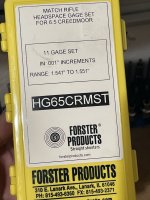Hi everyone
Just started reloading 2 months ago
Running into a interesting question:
I was measuring all my brasses that fired once in my 6.5cm bolt gun and seeing different headspace vary from 1.555 to 1.560. Out of those 77 brasses, 26 of them are 1.558 and about 15 of them 1.557
My question is
1-which one should I select to adjust my die to push shoulder back by 0.002?
Should I select 1.557 so all the cases become 1.555?
I already measured the c.b.t.o based on sized brass that has 1.558
2- should i do another measurement based on the longest case or shortest case?
Thanks
Just started reloading 2 months ago
Running into a interesting question:
I was measuring all my brasses that fired once in my 6.5cm bolt gun and seeing different headspace vary from 1.555 to 1.560. Out of those 77 brasses, 26 of them are 1.558 and about 15 of them 1.557
My question is
1-which one should I select to adjust my die to push shoulder back by 0.002?
Should I select 1.557 so all the cases become 1.555?
I already measured the c.b.t.o based on sized brass that has 1.558
2- should i do another measurement based on the longest case or shortest case?
Thanks



